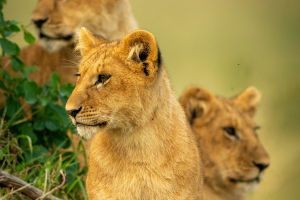Lynxes are solitary cats that live in the far regions of North America, Europe, and Asia’s northern woodlands. Their thick, gorgeous fur keeps them warm throughout the cold winter months. The lynx’s excellent vision has earned its legendary status in many civilizations’ mythologies. The cat is a creature in Greek, Norse, and North American mythology that sees what others cannot and can expose hidden secrets.
Usually, lynx steer clear of humans, but over the years we’ve been treated to videos of the elusive wild cats doing everything from fighting to hunting to relaxing outside a post office. While these encounters have taught us many things—namely that lynx do not respond positively to the call of “kitty kitty”—there’s still lots more to learn about the majestic lynx.
1. A baby lynx cannot survive without its mother
Without the mother, the young lynx would not survive the first winter. This is because the kittens develop very slowly and don’t open their eyes until after ten days. They can’t go out until about five weeks after birth, and weaning comes after two months. Young lynx may survive on their own at ten months, although they typically stay with their mother for close to a year and do not reach full maturity until they are two years old.
2. Lynxes are excellent hunters
Lynxes are formidable predators. They’ll go after any animal they feel they can take down. They don’t run as fast or as powerfully as some of their feline relatives; therefore, they hunt by sight and hearing. Because they dislike running after prey, they will approach quietly and pounce when the time is appropriate. Instead of pursuing their victim, they track and then ambush them. The rugged, forested environment makes this easier for them. A lynx may leap 6 feet into the air to hit a bird as it takes flight.
3. The lynx is in a close relationship with snowshoe hares
Snowshoe hares and lynx are so closely related that as the hare population declines, the lynx population also declines. Then, if the population rises again, the lynx population will increase too. Lynx must rely almost entirely on hares (90 percent of their diet) because there are so few good alternatives. According to the San Diego Zoo, a doctor released a disease called myxomatosis to control the rabbit population in his garden in the 1950s. As a result of the disease, the rabbit population was almost wiped out. Car hits, habitat loss, deforestation and illegal hunting are also contributing to the decline.
4. Lynxes do not move in groups
Lynxes are solitary animals that spend most of their lives on their own. They like to travel alone and keep to themselves. They get together when the female lynx is raising her offspring or when it’s time to mate. Kittens that have recently separated from their mother may travel and hunt together for many months before splitting up.
5. The female lynx only has one month to become pregnant
For lynx, the mating season is short. It’s similar to the 1800s wooing era. It lasts from February to March, and the pregnancy period is between 63 and 72 days. There’s only a little window of opportunity for potential mates. In their search for a mate, the males are fiercely competitive. The animal, which is otherwise silent, makes a high-pitched shriek that concludes in a protracted wail and engages in intense bouts with other male candidates.


